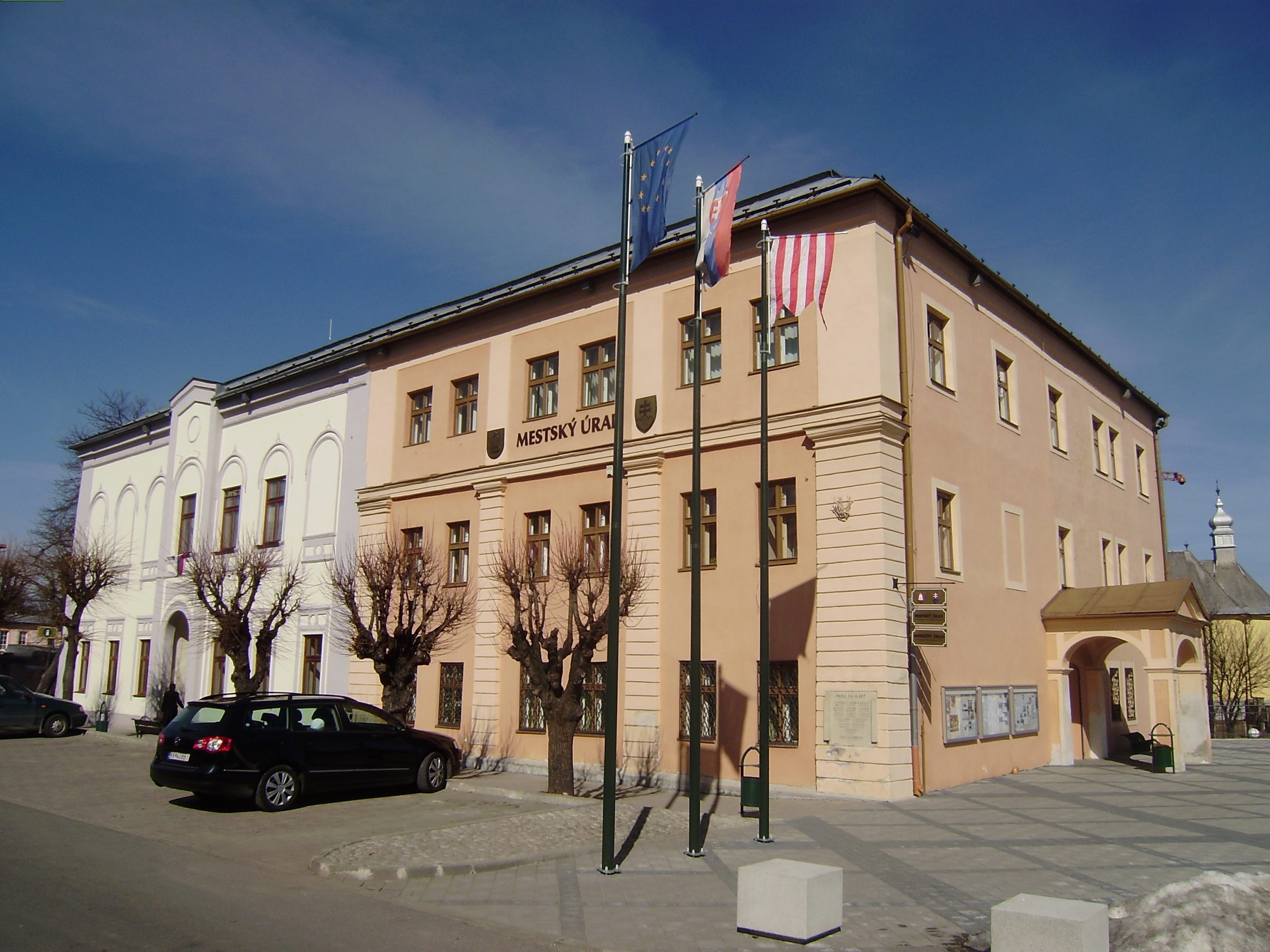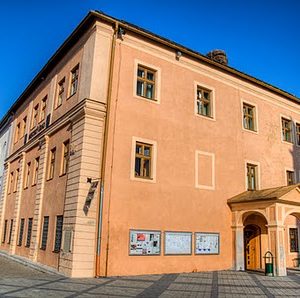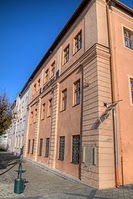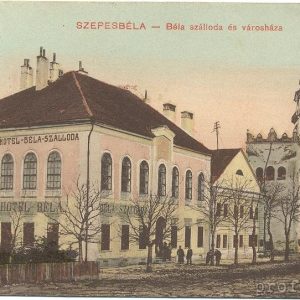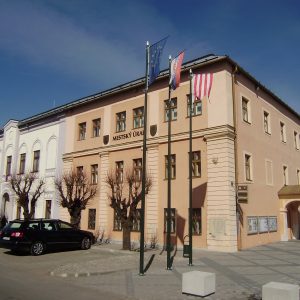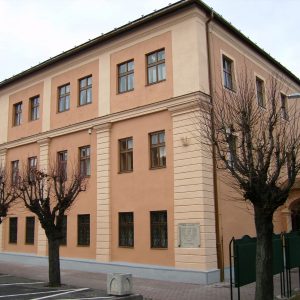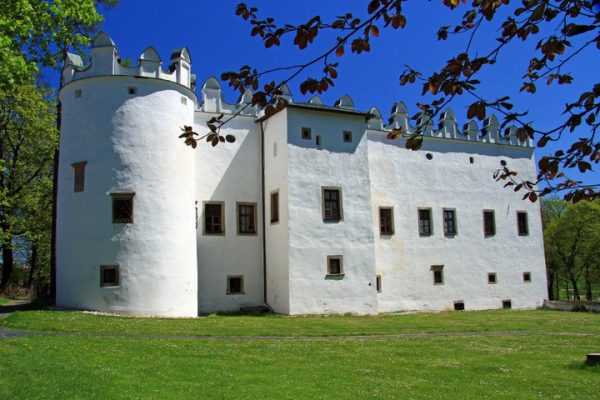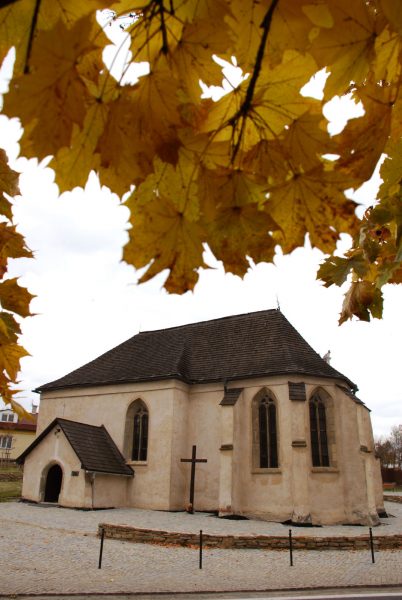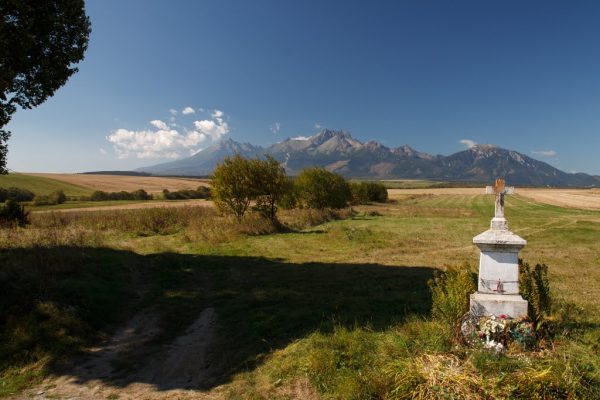8. Radnica (mestský úrad)
![]() Prvá písomná zmienka o Spišskej Belej sa údajne viazala k roku 1246. Listina bola zapísaná v zozname archívnych dokumentov uložených v mestskom archíve. Zoznam bol vyhotovený v roku 1944 pri jeho evakuácii. Počas evakuácie sa však niektoré listiny stratili. Prvá doložená písomná zmienka je z roku 1264. Predpokladá sa, že už v roku 1271 bola súčasťou Spoločenstva spišských Sasov nazývaného aj Spoločenstvom 24 kráľovských spišských miest, ktoré bolo vytvorené ako nová samosprávna jednotka popri spišskej stolici a Stolici 10 spišských kopijníkov. Po vymretí rodu Arpádovcov v roku 1301 sa v Uhorsku rozpútal zápas o uhorský trón. V tomto zápase sa spišské mestá na čele s Levočou postavili na stranu Karola Róberta. Svoju oddanosť mu Spoločenstvo spišských Sasov dokázalo pri bitke pri Rozhanovciach neďaleko Košíc. Môžeme predpokladať, že na bitke sa zúčastnili aj obyvatelia mesta, ako členovia tohto spoločenstva.. Kráľ sa odvďačil za vernosť v podobe Privilégií spišských Sasov. Spišská Belá sa zúčastňovala aj na Správe spoločenstva spišských Sasov či Provincie 24 spišských miest. Jej richtár bol členom rady spišského grófa a do ústrednej správy bol volený aj určitý počet občanov mesta. Mestské výsady používali iba mešťania. Do meštianskeho stavu však nemohol byť prijatý každý, musel spĺňať podmienky, ako napr. pochádzať zo zákonného manželstva, byť mravne bezúhonný, vyučený majster v nejakom remesle, musel vlastniť dom s poľnohospodárskym majetkom. Okrem mešťanov žila v meste skupina obyvateľov bez mestských práv, nazývaná želiarmi. Tí mali v prenájme domky uprostred mesta v tzv. jarku. V roku 1412 postihol obyvateľov 16 spišských miest, medzi ktoré patrila aj Spišská Belá, neobyčajne ťažký údel. Dostali sa do područia poľských kráľov ako záloh za peniaze, ktoré títo králi požičali uhorskému kráľovi Žigmundovi. Tento záloh trval 360 rokov. Kráľ Žigmund sa pokúšal už po siedmich rokoch vykúpiť zo zálohu, avšak poĺskí králi veľmi rýchlo pochopili, aké bohatstvo a výhody im prináša spravovanie týchto miest, a preto sa všemožne bránili a čas trvania zálohu ukazuje, že sa aj úspešne bránili vráteniu miest. Záloh trval de jure do roku 1772, de facto pre Spišskú Belú do 10. mája roku 1769, keď mesto vojensky obsadila Mária Terézia. Spišská Belá mala už v 15. storočí mestskú kanceláriu a na základe dochovanej pečate môžeme predpokladať, že už vtedy mala svojho notára. Keďže sa nezachovali správy o radnici, domnievame sa, že richtár s prísažnými úradoval vo svojom dome. Samuel Weber (1892) k radnici poznamenáva, že nikde nie je napísané, kedy bola postavená. Ale poznamenáva, že už v roku 1637 podľa záznamov existovala a neskôr bola opakovane prestavovaná. Ďalšia prestavba sa uskutočnila v rokoch 1771 -1774, kedy ju odovzdali do užívania.
Prvá písomná zmienka o Spišskej Belej sa údajne viazala k roku 1246. Listina bola zapísaná v zozname archívnych dokumentov uložených v mestskom archíve. Zoznam bol vyhotovený v roku 1944 pri jeho evakuácii. Počas evakuácie sa však niektoré listiny stratili. Prvá doložená písomná zmienka je z roku 1264. Predpokladá sa, že už v roku 1271 bola súčasťou Spoločenstva spišských Sasov nazývaného aj Spoločenstvom 24 kráľovských spišských miest, ktoré bolo vytvorené ako nová samosprávna jednotka popri spišskej stolici a Stolici 10 spišských kopijníkov. Po vymretí rodu Arpádovcov v roku 1301 sa v Uhorsku rozpútal zápas o uhorský trón. V tomto zápase sa spišské mestá na čele s Levočou postavili na stranu Karola Róberta. Svoju oddanosť mu Spoločenstvo spišských Sasov dokázalo pri bitke pri Rozhanovciach neďaleko Košíc. Môžeme predpokladať, že na bitke sa zúčastnili aj obyvatelia mesta, ako členovia tohto spoločenstva.. Kráľ sa odvďačil za vernosť v podobe Privilégií spišských Sasov. Spišská Belá sa zúčastňovala aj na Správe spoločenstva spišských Sasov či Provincie 24 spišských miest. Jej richtár bol členom rady spišského grófa a do ústrednej správy bol volený aj určitý počet občanov mesta. Mestské výsady používali iba mešťania. Do meštianskeho stavu však nemohol byť prijatý každý, musel spĺňať podmienky, ako napr. pochádzať zo zákonného manželstva, byť mravne bezúhonný, vyučený majster v nejakom remesle, musel vlastniť dom s poľnohospodárskym majetkom. Okrem mešťanov žila v meste skupina obyvateľov bez mestských práv, nazývaná želiarmi. Tí mali v prenájme domky uprostred mesta v tzv. jarku. V roku 1412 postihol obyvateľov 16 spišských miest, medzi ktoré patrila aj Spišská Belá, neobyčajne ťažký údel. Dostali sa do područia poľských kráľov ako záloh za peniaze, ktoré títo králi požičali uhorskému kráľovi Žigmundovi. Tento záloh trval 360 rokov. Kráľ Žigmund sa pokúšal už po siedmich rokoch vykúpiť zo zálohu, avšak poĺskí králi veľmi rýchlo pochopili, aké bohatstvo a výhody im prináša spravovanie týchto miest, a preto sa všemožne bránili a čas trvania zálohu ukazuje, že sa aj úspešne bránili vráteniu miest. Záloh trval de jure do roku 1772, de facto pre Spišskú Belú do 10. mája roku 1769, keď mesto vojensky obsadila Mária Terézia. Spišská Belá mala už v 15. storočí mestskú kanceláriu a na základe dochovanej pečate môžeme predpokladať, že už vtedy mala svojho notára. Keďže sa nezachovali správy o radnici, domnievame sa, že richtár s prísažnými úradoval vo svojom dome. Samuel Weber (1892) k radnici poznamenáva, že nikde nie je napísané, kedy bola postavená. Ale poznamenáva, že už v roku 1637 podľa záznamov existovala a neskôr bola opakovane prestavovaná. Ďalšia prestavba sa uskutočnila v rokoch 1771 -1774, kedy ju odovzdali do užívania.
V roku 1844 sa úradnou rečou stala maďarčina, ktorá vystriedala nemčinu. V roku 1899 bol zriadený magistrát. Na čele mesta stál volený mešťanosta, mestská rada a mestské zastupiteľstvo tvorili 24 volení občania a 24 virilisti (najbohatší občania mesta). V mestskom zastupiteľstve boli okrem iných aj evanjelický farár a historik Samuel Weber a dr. Michal Greisiger .
Nachádzame sa pred budovou mestskej radnice, ktorá vznikla spojením dvoch pôvodných objektov. Pravá časť budovy slúži aj dnes pôvodnému účelu. Dvojposchodová budova radnice má v hlavnom priečelí tri dvojice okien. K bočnej strane prilieha vstupný prístrešok, ktorým sa vstupuje do pozoruhodných pivníc, ktoré pochádzajú až z roku 1637 a majú gotickorenesančný pôvod .
Ľavú časť budovy mesto odkúpilo v roku 1872 od Banklocalu. V tom istom roku ju aj zbúrali a na jej mieste postavili novú budovu. Na prízemí sa nachádzala honosná kaviareň, na poschodí spoločenská sála. Neskôr sa tento priestor prebudoval na kino. Historizujúco hodnotné priečelie bolo porušené odstránením plastických prvkov členenia čiastočným zamurovaním okien, ktoré boli na poschodí zmenené na obdĺžnikové. Koncom päťdesiatych rokov sa mesto podujalo radnicu rekonštruovať.
Budovu, ktorá dovtedy bola jednoposchodová a prikrytá šindľom, odstránili a sedlovú strechu nahradili rovnou a znížili murovaný štít, ktorý smeroval do cesty. Z pamiatkového hľadiska to bol veľmi necitlivý krok, ktorý rušivo zasiahol do historického vzhľadu jadra mesta. V roku 1971 pri oprave radnice sa stavebne i spoločnou strechou obe budovy spojili do dominantnej dvojbudovy . V roku 1971 bol temer od základov prestavaný zadný trakt budovy.
8. Town Hall
![]() We assume that the first written record of Spišská Belá dates from 1246. This document was listed in the city’s archive’s registry, which was completed in 1944 and evacuated in the same year. Some documents were lost in the evacuation. The first preserved written record of the town dates from 1264. It is assumed that in 1271 already, the town was a part of the Society of the Saxons in Spiš, also known as the Society of the 24 Royal Spiš towns; it was formed as a new administrative unit as part of the Spiš region and the so-called Ten Spiš Lancers’ Province. After the demise of the Arpád dynasty in 1301, a race for the throne took place in Hungary. In this race, the towns of Spiš, headed by Levoča, sided with Karol Róbert. The association of Spiš territories demonstrated its allegiance with him in the Battle of Rozgony, not far from Košíce. We can assume that as members of this association, the town’s residents participated in the battle. The king rewarded their loyalty by granting the Society of the Saxons in Spiš special privileges. Spišská Belá also helped with the administration of the Saxons in Spiš, or the provinces of the 24 towns of the Spiš region. The town’s judge was a member of the council of the count of Spiš and several of the town’s residents were also elected into the regional council. However, not everyone was able to rise to the status of townsman; a number of conditions were tied to it, for example a legal marriage and impeccable morals. It was required that one be a master craftsman in a specific trade and own a house as well as farmland. Besides the townsmen, the town was also a home to a group of residents who did not have citizens‘ privileges, and were referred to as želiari, or serfs. They lived in rental houses in town, in the so-called jark. In 1412, the residents of the 16 towns of the Spiš region, among them Spišská Belá, faced an unusual hardship. They fell under the authority of Polish kings as a security for money that those kings had lent the Hungarian King Žigmund. This period lasted 360 years. After 7 years, King Žigmund tried to buy back the territory, but the Polish kings had quickly understood what riches and advantages the administration of those towns could bring them and resisted giving them back by all means, and, as the length of this period shows, they were quite successful. This period, by law, was to expire in 1772, de facto, in the case of Spišská Belá, it ended on May 10, 1769, when the town was seized by Mária Terézia. As early as the 15th century, Spišská Belá had a town court and we can assume, on the basis of preserved seals, that the town also had its own notary. Seeing that no documentation of a town hall exists, it is assumed that the judge and his jurors convened in the judge’s house. In 1892, Samuel Weber remarked on the town hall, noting that it does not bear an inscription of when it was built. He added that according to some documents, it already existed in 1637 and that it was later reconstructed several times. Another reconstruction took place between 1711- 1774, which he no longer was able to witness.
We assume that the first written record of Spišská Belá dates from 1246. This document was listed in the city’s archive’s registry, which was completed in 1944 and evacuated in the same year. Some documents were lost in the evacuation. The first preserved written record of the town dates from 1264. It is assumed that in 1271 already, the town was a part of the Society of the Saxons in Spiš, also known as the Society of the 24 Royal Spiš towns; it was formed as a new administrative unit as part of the Spiš region and the so-called Ten Spiš Lancers’ Province. After the demise of the Arpád dynasty in 1301, a race for the throne took place in Hungary. In this race, the towns of Spiš, headed by Levoča, sided with Karol Róbert. The association of Spiš territories demonstrated its allegiance with him in the Battle of Rozgony, not far from Košíce. We can assume that as members of this association, the town’s residents participated in the battle. The king rewarded their loyalty by granting the Society of the Saxons in Spiš special privileges. Spišská Belá also helped with the administration of the Saxons in Spiš, or the provinces of the 24 towns of the Spiš region. The town’s judge was a member of the council of the count of Spiš and several of the town’s residents were also elected into the regional council. However, not everyone was able to rise to the status of townsman; a number of conditions were tied to it, for example a legal marriage and impeccable morals. It was required that one be a master craftsman in a specific trade and own a house as well as farmland. Besides the townsmen, the town was also a home to a group of residents who did not have citizens‘ privileges, and were referred to as želiari, or serfs. They lived in rental houses in town, in the so-called jark. In 1412, the residents of the 16 towns of the Spiš region, among them Spišská Belá, faced an unusual hardship. They fell under the authority of Polish kings as a security for money that those kings had lent the Hungarian King Žigmund. This period lasted 360 years. After 7 years, King Žigmund tried to buy back the territory, but the Polish kings had quickly understood what riches and advantages the administration of those towns could bring them and resisted giving them back by all means, and, as the length of this period shows, they were quite successful. This period, by law, was to expire in 1772, de facto, in the case of Spišská Belá, it ended on May 10, 1769, when the town was seized by Mária Terézia. As early as the 15th century, Spišská Belá had a town court and we can assume, on the basis of preserved seals, that the town also had its own notary. Seeing that no documentation of a town hall exists, it is assumed that the judge and his jurors convened in the judge’s house. In 1892, Samuel Weber remarked on the town hall, noting that it does not bear an inscription of when it was built. He added that according to some documents, it already existed in 1637 and that it was later reconstructed several times. Another reconstruction took place between 1711- 1774, which he no longer was able to witness.
In 1844, Hungarian replaced German as the official language. A magistrate was established in 1899. The town was lead by an elected mayor, and the town’s board and council were composed of 24 elected citizens as well as 24 representatives of the town’s richest class. Among others, the Protestant vicar Samuel Weber and Dr. Michal Greisiger were members of the town council.
We are standing in front of the town hall building, which was created by joining two individual buildings together. Its right side serves a similar purpose today. The one-storied town hall building’s façade has three double windows. On the backside of the building, an entrance with a canopy leads to a remarkable beer hall, which dates back to 1637 and was originally built in the Gothic-Renaissance style.
The left side of the building was purchased by the town from a local bank in 1872. That same year, it was torn down and in its place, a new building was erected. A magnificent coffee house was located on the ground floor, and on the first floor, a ballroom. Later, this space was transformed into a cinema. The historically precious façade was damaged when some windows were walled in and some sculptural elements removed. On the first floor, the windows were transformed into rectangular ones. At the end of the 1950s, the town decided to renovate the town hall.
The building had just one floor until then and was covered by a shingle roof, which was removed and replaced by a flat roof, and the builders lowered the coat-of-arms, which faced the road. From the point of view of historical preservation, this was a very insensitive step, which damaged the city’s historical core. In 1971, during the repair of the building, it was joined to a neighboring building both structurally as well as by a common roof, which created a very dominant double house. In 1971, the back part of the building underwent a very radical renovation.
8. Das Rathaus
![]() Die erste schriftliche Erwähnung von Zipser Bela bezieht sich angeblich auf das Jahr 1246. Die Urkunde wird in einem Verzeichnis von Archivdokumenten erwähnt, die im Stadtarchiv aufbewahrt sind. Das Verzeichnis hatte man 1944 bei seiner Auslagerung angefertigt. Während der Auslagerung sind allerdings einige Urkunden verlorengegangen. Die erste nachweisbare schriftliche Erwähnung stammt aus dem Jahre 1264. Man nimmt an, dass Zipser Bela bereits 1271 zum Bund der Zipser Sachsen gehörte, der auch Bund der 24 Zipser königlichen Städte genannt wird und als neue Selbstverwaltungseinheit neben das Zipser Komitat und das Komitat der 10 Zipser Lanzenträger trat. Nach dem Aussterben der Arpaden im Jahre 1301 entbrannte in Ungarn ein Kampf um die Thronnachfolge. In dieser Auseinandersetzung stellten sich die Zipser Städte, angeführt von der Stadt Leutschau, auf die Seite von Karl dem I. Robert. Seine Ergebenheit stellte der Bund der Zipser Sachsen in der Schlacht bei Rozhanovce / Roschowetz unweit von Kaschau / Košíce unter Beweis. Wir dürfen annehmen, dass an dieser Schlacht auch Bewohner der Stadt als Mitglieder dieses Bundes teilnahmen. Für die ihm erwiesene Treue zeigte sich der König dadurch erkenntlich, dass er den Zipser Sachsen Privilegien verlieh. Zipser Bela war auch an der Verwaltung des Bundes der Zipser Sachsen beziehungsweise der Provinz der 24 Zipser Städte beteiligt. Ihr Schultheiß war Ratsmitglied des Zipser Grafen, und auch eine bestimmte Anzahl von Stadtbewohnern war in die Zentralverwaltung gewählt worden. Die städtischen Privilegien kamen ausschließlich den Bürgern zugute. Doch nicht jedermann konnte so einfach in den Bürgerstand aufgenommen werden, sondern musste bestimmte Bedingungen erfüllen. Dazu gehörte, dass er aus einer gesetzlichen Ehe abstammen musste, sittlich unbescholten war, ein gelernter Handwerksmeister sein musste und ein Haus mit Agrarland besaß.
Die erste schriftliche Erwähnung von Zipser Bela bezieht sich angeblich auf das Jahr 1246. Die Urkunde wird in einem Verzeichnis von Archivdokumenten erwähnt, die im Stadtarchiv aufbewahrt sind. Das Verzeichnis hatte man 1944 bei seiner Auslagerung angefertigt. Während der Auslagerung sind allerdings einige Urkunden verlorengegangen. Die erste nachweisbare schriftliche Erwähnung stammt aus dem Jahre 1264. Man nimmt an, dass Zipser Bela bereits 1271 zum Bund der Zipser Sachsen gehörte, der auch Bund der 24 Zipser königlichen Städte genannt wird und als neue Selbstverwaltungseinheit neben das Zipser Komitat und das Komitat der 10 Zipser Lanzenträger trat. Nach dem Aussterben der Arpaden im Jahre 1301 entbrannte in Ungarn ein Kampf um die Thronnachfolge. In dieser Auseinandersetzung stellten sich die Zipser Städte, angeführt von der Stadt Leutschau, auf die Seite von Karl dem I. Robert. Seine Ergebenheit stellte der Bund der Zipser Sachsen in der Schlacht bei Rozhanovce / Roschowetz unweit von Kaschau / Košíce unter Beweis. Wir dürfen annehmen, dass an dieser Schlacht auch Bewohner der Stadt als Mitglieder dieses Bundes teilnahmen. Für die ihm erwiesene Treue zeigte sich der König dadurch erkenntlich, dass er den Zipser Sachsen Privilegien verlieh. Zipser Bela war auch an der Verwaltung des Bundes der Zipser Sachsen beziehungsweise der Provinz der 24 Zipser Städte beteiligt. Ihr Schultheiß war Ratsmitglied des Zipser Grafen, und auch eine bestimmte Anzahl von Stadtbewohnern war in die Zentralverwaltung gewählt worden. Die städtischen Privilegien kamen ausschließlich den Bürgern zugute. Doch nicht jedermann konnte so einfach in den Bürgerstand aufgenommen werden, sondern musste bestimmte Bedingungen erfüllen. Dazu gehörte, dass er aus einer gesetzlichen Ehe abstammen musste, sittlich unbescholten war, ein gelernter Handwerksmeister sein musste und ein Haus mit Agrarland besaß.
Außer Bürgern lebte in der Stadt auch eine Gruppe von Menschen, die keine Bürgerrechte besaßen, die sogenannten Häusler. Sie hatten Häuser inmitten der Stadt zur Untermiete, im sogenannten Graben. 1412 ereilte die Bewohner der 16 Zipser Städte, darunter auch die von Zipser Bela, ein ungewöhnlich schweres Schicksal. Sie kamen unter die Botmäßigkeit der polnischen Könige, und zwar als Pfand für jenes Geld, das diese Könige dem ungarischen Monarchen Sigmund geliehen hatten. Dieses Pfand währte 360 Jahre. Bereits nach sieben Jahren versuchte König Sigmund, diesen Pfand loszukaufen, doch die polnischen Könige erkannten sehr schnell, welchen Reichtum und welche Vorteile ihnen die Verwaltung dieser Städte brachte, weshalb sie sich mit allen Mitteln und erfolgreich einer Rückgabe der Städte widersetzten. Das Pfand dauerte de jure bis 1772, für Zipser Bela aber de facto bis zum 10. Mai 1769, als die Stadt von Maria Theresia militärisch besetzt wurde. Bereits im 15. Jahrhundert hatte Zipser Bela eine städtische Kanzlei, und anhand eines erhaltenen Siegels können wir annehmen, dass die Stadt schon damals ihren Notar hatte. Weil sich keine Nachrichten über das Rathaus erhalten haben, glauben wir, dass der Schultheiß mit den Schöffen in seinem Haus amtierte. Samuel Weber bemerkt zum Rathaus, dass nirgendwo geschrieben steht, wann es eigentlich erbaut wurde. Zugleich sagt er aber, dass es laut Aufzeichnungen bereits 1637 existierte und später wiederholt umgebaut wurde. Ein weiterer Umbau erfolgte in den Jahren 1771 – 1774, als man es seiner Verwendung übergab.
Im Jahre 1844 wurde Ungarisch Amtssprache und löste darin die deutsche Sprache ab. 1899 entstand der Magistrat. An der Spitze der Stadt stand ein gewählter Oberbürgermeister. Den Stadtrat und die Stadtvertretung bildeten 24 gewählte Bürger und 24 Virilisten, also Männer, die aufgrund ihres Amtes (Bischöfe, Universitätsrektoren u. a.) einen Sitz in der gesetzgebenden Körperschaft innehatten. In der Stadtvertretung saßen unter anderem auch der evangelische Pfarrer und Historiker Samuel Weber und Dr. Michal Greisiger.
Wir stehen jetzt vor dem Rathaus, dessen Gebäude durch die Zusammenlegung zweier ursprünglicher Objekte entstand. Der rechte Gebäudeteil dient auch heute noch seinem ursprünglichen Zweck. Das zweistöckige Rathausgebäude weist in seiner Hauptfassade drei Doppelfenster auf. Seitlich schließt das Vordach eines Eingangs an, durch den man in bemerkenswerte Keller gelangt, die aus dem Jahr 1637 stammen und gotisch-renaissancenen Ursprungs sind.
Den linken Gebäudeteil kaufte die Stadt 1872 vom Banklokal ab. In demselben Jahr wurde dieser Gebäudeteil eingerissen und an seiner Stelle ein neues Gebäude errichtet. Im Erdgeschoss befand sich ein vornehmes Café, im ersten Stock ein Gesellschaftssaal, den man bald darauf zu einem Kino umbaute. Die wertvolle historisierende Fassade wurde dadurch gemindert, dass man die plastischen Bauelemente der Gliederung entfernte und die Fenster teilweise zumauerte. Die Fenster im Obergeschoss baute man zu rechteckigen Fenstern um. Ende der fünfziger Jahre nahm sich die Stadt der Rekonstruktion des Rathauses an. Das bis dahin einstöckige und mit Schindeln gedeckte Gebäude wurde beseitigt und das Satteldach durch ein Flachdach ersetzt; gleichzeitig senkte man den gemauerten Giebel, der zur Straße hinwies. Vom Standpunkt der Denkmalspflege aus war dies ein sehr liebloser Schritt, der störend in das historische Äußere des Stadtkerns eingriff. 1971 hat man bei der Instandsetzung des Rathauses beide Gebäude unter das gemeinsame Dach zu einem dominanten Doppelgebäude verbunden. Im selben Jahr wurde auch der hintere Gebäudetrakt fast von Grund auf umgebaut.
8. Ratusz
![]() Pierwsza pisemna wzmianka o Białej Spiskiej odnosiła się podobno do 1246 roku, o czym wiemy ze spisu dokumentów archiwum miejskiego, sporządzonego w roku 1944 przy jego ewakuacji. Niestety niektóre dokumenty podczas tej ewakuacji zaginęły.
Pierwsza pisemna wzmianka o Białej Spiskiej odnosiła się podobno do 1246 roku, o czym wiemy ze spisu dokumentów archiwum miejskiego, sporządzonego w roku 1944 przy jego ewakuacji. Niestety niektóre dokumenty podczas tej ewakuacji zaginęły.
Pierwsze udokumentowane źródło pisane o mieście pochodzi z 1264 roku. Uważa się, że w 1271 roku Biała Spiska należała do Związku Sasów Spiskich, późniejszego Związku 24 Miast Królewskich, który został utworzony jako nowa jednostka samorządowa obok stolicy spiskiej (żupy spiskiej) i Stolicy X Spiskich Kopijników (tzw. Małej Żupy). Po wygaśnięciu rodu Arpadów w 1301 roku na Węgrzech rozgorzała walka o tron. W walce tej miasta spiskie na czele z Lewoczą stanęły po stronie Karola Roberta. Swoje oddanie Związek Sasów Spiskich udowodnił podczas bitwy pod Rozhanovcami niedaleko Koszyc. Możemy przypuszczać, że w bitwie brali udział mieszkańcy miasta jako członkowie tego związku. Król odwdzięczył się za wierność nadając im Przywileje Spiskich Sasów. Biała Spiska była włączona także do zarządu Związku Sasów Spiskich, później Prowincji 24 miast spiskich. Starosta miasta był członkiem rady księcia spiskiego. Do głównego zarządu wybierano także określoną liczbę obywateli miasta. Przywileje te dotyczyły jednak wyłącznie mieszczan, a nie każdy mógł być mieszczaninem. Aby nim zostać, trzeba było spełniać wiele warunków, np. pozostawać w uświęconym związku małżeńskim, mieć nieposzlakowaną moralność, zdobyć tytuł mistrza któregoś z rzemiosł, posiadać dom wraz z gospodartwem. Oprócz mieszczan miasto zamieszkiwała grupa obywateli nie posiadających praw miejskich. Nazywano ich żelarami. Żyli oni w niewielkich wynajmowanych domach w środku miasta, w tzw. jarku.
W 1412 roku dla obywateli 16 spiskich miast, wśród nich także Białej Spiskiej, nastała znacząca zmiana. Miasta te przeszły pod panowanie polskiego króla Władysława Jagiełły jako zastaw za pożyczkę, której udzielił węgierskiemu oraz niemieckiemu królowi Zygmuntowi Luksemburskiemu. Ten zastaw trwał 360 lat. Król Zygmunt próbował już po siedmiu latach wykupić dług, ale polscy królowie szybko zrozumieli jakie dochody i korzyści przynoszą im posiadane miasta. Długo skutecznie bronili się przed ich oddaniem. Zastaw przeciągnął się aż do roku 1772 de jure, de facto dla Białej Spiskiej do 10 maja 1769, kiedy to do miasta wkroczyły wojska cesarzowej Marii Teresy.
W Białej Spiskiej istniała już w XV wieku kancelaria miejska, a na podstawie zachowanej pieczęci przypuszcza się, że miasto posiadało również notariusza. Ponieważ nie zachowały się informacje o ratuszu, zakłada się, że starosta wraz z radnymi urzędował w swoim domu. Samuel Weber (1892) odnotował, że nie istnieją zapiski o tym, kiedy ratusz był postawiony.Z dokumentów wynika jednak, że istniał już w 1637 roku i był kilkakrotnie przebudowywany. Po przebudowie w latach 1771 – 1774 ratusz został oddany do użytku.
W 1844 roku językiem urzędowym był język węgierski, który później został zastąpiony przez język niemiecki. W 1899 roku utworzono magistrat. Na czele miasta stał pochodzący z wyborówy burmistrz oraz rada miejska, składająca się z 24 wybranych obywateli i 24 najbogatszych obywateli miasta (virilistów). We władzach miasta znaleźli się także między innymi pastor ewangelicki i historyk Samuel Weber oraz dr Michał Greisiger.
Znajdujemy się przed budynkiem ratusza miejskiego, który powstał z połączenia dwóch różnych budynków. Prawa część służy do dziś swemu celowi. Na głównej fasadzie dwupiętrowego budynku widać trzy podwójne okna. Z boku przez zadaszone wejście wchodzi się do zabytkowych gotycko-renesansowych piwnic z roku 1637. Lewą część budynku miasto odkupiło w 1872 roku od Banklocalu. Jeszcze w tym samy roku na jego miejscu postawiono nowy budynek, na parterze którego znalazła się słynna kawiarnia, a na piętrze aula. Budynek następnie został przebudowany na kino. Historyzująca fasada została naruszona przez usunięcie elementów ozdobnych i częściowe zamurowanie okien, które na piętrze uzyskały kształt prostokątów. W końcu lat pięćdziesiątych miasto przystąpiło do odnowy ratusza. Dotychczasowy jednopiętrowy budynek kryty gontem został usunięty, płaski dach zastąpił dach dwuspadowy, a murowany szczyt od strony drogi uległ obniżeniu. Z punktu widzenia konserwatorskiego było to bardzo niefortunne rozwiązanie, ponieważ naruszył historyczny wygląd centrum miasta. W roku 1971 podczas remontu ratusza oba budynki zostały połączone i przykryte wspólnym dachem. Wtedy też został od podstaw przebudowany tylny trakt budynku.

